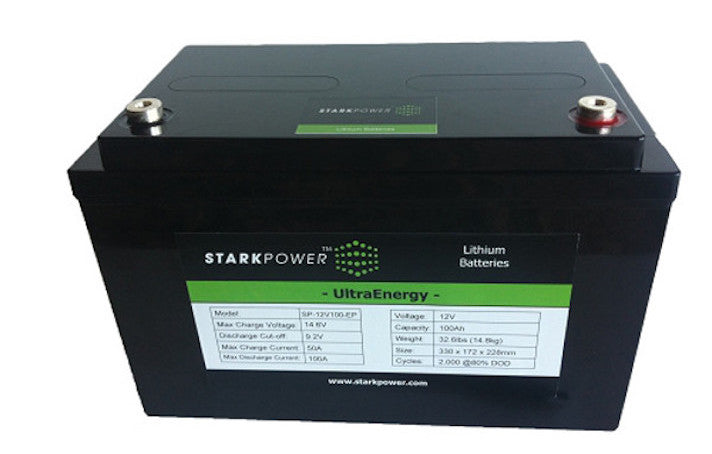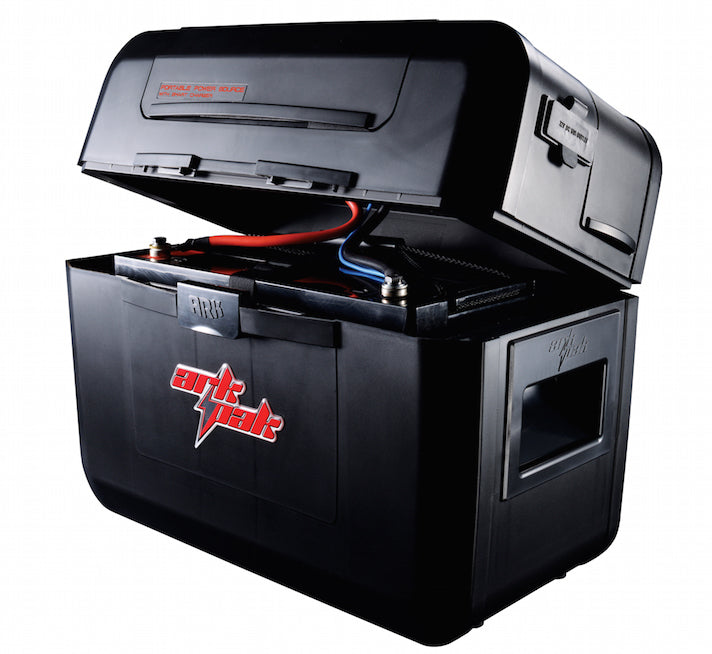Comparing a deep cycle lithium iron phosphate (LiFePO4) battery to a deep cycle lead-acid battery is like comparing a new Formula 1 race car to a used Miata: While the LiFePO4 battery is better than lead acid in just about every measurable way, the cost difference is extreme. Generally, deep cycle lithium iron phosphate batteries cost 3-10 times as much as a similarly sized deep cycle lead-acid battery. At this premium price, they should perform better.
Still, for the extra cost, there are a lot of advantages with LiFePO4 batteries. Here's a rundown of the differences to help you decide between the two batteries, both of which are compatible with the newest version of the top-of-the-line ArkPak.
Lead Acid Batteries - Pros and Cons
The lead acid battery has been around since the 1800's, and is perhaps the oldest type of battery design available. Yet despite the introduction of newer battery technologies, lead acids remain quite popular. Lead-acid batteries account for about 40% of the batteries sold in the world. This popularity is partially a result of the reliability of lead-acid batteries, but also a result of their low cost.
Indeed, the main argument favoring the lead acid battery is that they offer substantial benefits at a low cost.

Pros
- Readily available. You can find a lead-acid battery just about anywhere you find auto parts.
- Very affordable - a Group 31 size deep cycle lead-acid battery with 100ah of capacity will cost $150 - $300, depending on type and quality.
- Lead acids are reliable and durable - they're built to take a lot of abuse, especially in automotive applications where vibration can be a serious problem.
Cons
- They're (relatively) heavy. Compared to LiFePO4 batteries, lead-acids have a low energy-to-weight ratio.
- Shorter lifespan and cycle life than LiFePO4 batteries, especially when they're deeply discharged.
- Discharging deep-cycle lead-acid batteries below 20% (and sometimes 50%) permanently reduces the battery's capacity.
- There are some concerns about gas discharge and acid leakage, only this is relatively rare on newer maintenance free batteries.
- High current loads rapidly diminish rated capacity...most deep-cycle lead acid batteries are designed for slow, steady discharge over a 20+ hour period. if the time frame is reduced, the capacity rating drops.
Finally, it's important to note that there are different types of lead-acid batteries, each of which has their own pros and cons. Gel and AGM batteries are the most expensive, but they are also the most durable and last the longest. "Wet" batteries are available in maintenance free configurations or they can require periodic refilling. The advantage in these wet batteries is lower cost and - if they're the type that require maintenance - they often times have more energy capacity.
In the case of the ArkPak, the largest battery that will fit inside is a Group 31. It's possible to find a 130ah wet battery in the group 31 size, but it's not at all easy to find anything bigger than 100ah in a group 31 battery if you only look at sealed, AGM, or gel batteries (most of what we find that will fit in the ArkPak is 100ah or less).
Lithium Iron Phosphate Batteries - Pros and Cons
While there are quite a few common types of lithium ion batteries (with more being invented every day, it seems), lithium iron phosphate batteries have been around a couple of decades or so (invented in 1996). This particular battery chemistry is popular in automotive applications, as it's durable, stable, and well-suited to starting vehicles. Deep-cycle lithium iron phosphate batteries also strike a good balance between energy storage and life-span...they can be depended upon for years of use.

Pros
- Long life span (5-10 years) vs lead acid (1-3 years), depending on depth of discharge and assuming that the cycle limit doesn't kill the battery first
- Longer cycle life, as LiFePO4 batteries last 1,000 to 3,000 charge and discharge cycles, compared to similarly sized lead-acid batteries, which can range from 200 - 1000 cycles (again, assuming depth of discharge is within recommended limits for both battery types).
- LiFePO4 batteries are less susceptible to problems caused by depth of discharge...a LiFePO4 battery can be dropped to 20% of charge without long-term damage. Most lead-acid batteries lose capacity or cycle life if they're discharged more than 50%.
- Lighter than lead-acid batteries.
- Arguably, LiFePO4 batteries are more environmentally friendly than lead acid.
- Very safe - the odds of a "thermal runaway" (aka battery fire) are very low. The same can not be said of other lithium ion chemistries.
Cons
- As mentioned, LiFePO4 batteries are costly.
- LiFePO4 batteries are hard to find. Most must be purchased online.
- Susceptible to damage via overcharging (it's very important to use a charging system that's designed for LiFePO4 batteries if you want to maximize their life).
As stated in the introduction, deep cycle LiFePO4 batteries are better than deep-cycle lead-acid batteries in just about every measurable way. But they're 3-10 times more costly, with a 100ah or 125ah Group 31 size LiFePO4 battery running between $1,000 on the low end and $3,000+ on the high end (as of August, 2015).
Which Battery Should You Get?
Assuming that both batteries are in the budget, the question of which to buy really comes down to a handful of decisions:
- Do you need to reduce weight? A DieHard Marine 100ah group 31 deep cycle lead-acid battery weighs in at 75lbs. A similar capacity LiFePO4 battery from Stark Power is 28lbs. In a racing application, 47lbs could be an important difference.
- Do you need more than 50ah of battery capacity between charges? A lead-acid battery functions best when it's discharged less than 50%. If your lead acid battery has 100ah of capacity, this translates to 50ah usable capacity "limit", at least if you want to maximize battery life. An LiFePO4 battery can go up to 80% depth of discharge without compromising life span (80ah, using our 100ah battery example), so it's better if you need more power between charges.
- Do you need to draw a lot of current for a short period? A LiFePO4 battery is more effective at delivering a large amount of current over a short period than a lead acid battery. If you need a battery that can power a 40 amp device for two hours straight, LiFePO4 is the way to go. Most lead-acids - even if they're rated at 100ah and discharged to 20% - will fail that requirement, as their max rated capacity is based on a slower current draw.
- Is the battery hard to replace? If you have an ArkPak, the answer is probably no. But if you're mounting a deep-cycle battery in a place where it's difficult to replace, a LiFePO4 battery is a better option. All things being equal, it will last 2-3 times longer than a lead acid with same capacity in terms of charge/discharge cycles, and 3-5 times longer in terms of actual life span (years of function).
- Do you have a charger designed to work with LiFePO4 batteries? Most of the battery chargers you can buy at your local Wal-Mart or auto parts store are "bulk" chargers, meaning that they're good for getting a dead battery back to a functional level (so you can get your vehicle started), but not at all good for LiFePO4 batteries. In fact, a standard bulk charger will ruin a LiFePO4 battery very quickly. You need a charger specifically for LiFePO4 batteries if you want them to last.
NOTE: If you're buying the top-of-the-line ArkPak, you'll be getting a unit that works well with LiFePO4 batteries, including overcharge protections. The new ArkPak 730 Portable Power automatically detects the battery chemistry and charges accordingly.

Finally, when it comes to choosing between batteries, it's worth noting that the cost difference between an LiFePO4 battery and a lead-acid battery isn't so tremendous depending on brand and type. The DieHard battery we linked to, for example, costs nearly $300. If you discharge it 50% or less, and do so daily, it will probably last 2-3 years. If you used a new StarkPower LiFePO4 battery (also linked to) the same way, it would last 8 years (perhaps longer).
Over the course of 8 years, you might end up buying four lead acids to do the same job that one LiFePO4 battery does. At that point, the cost difference between the two isn't so great.
